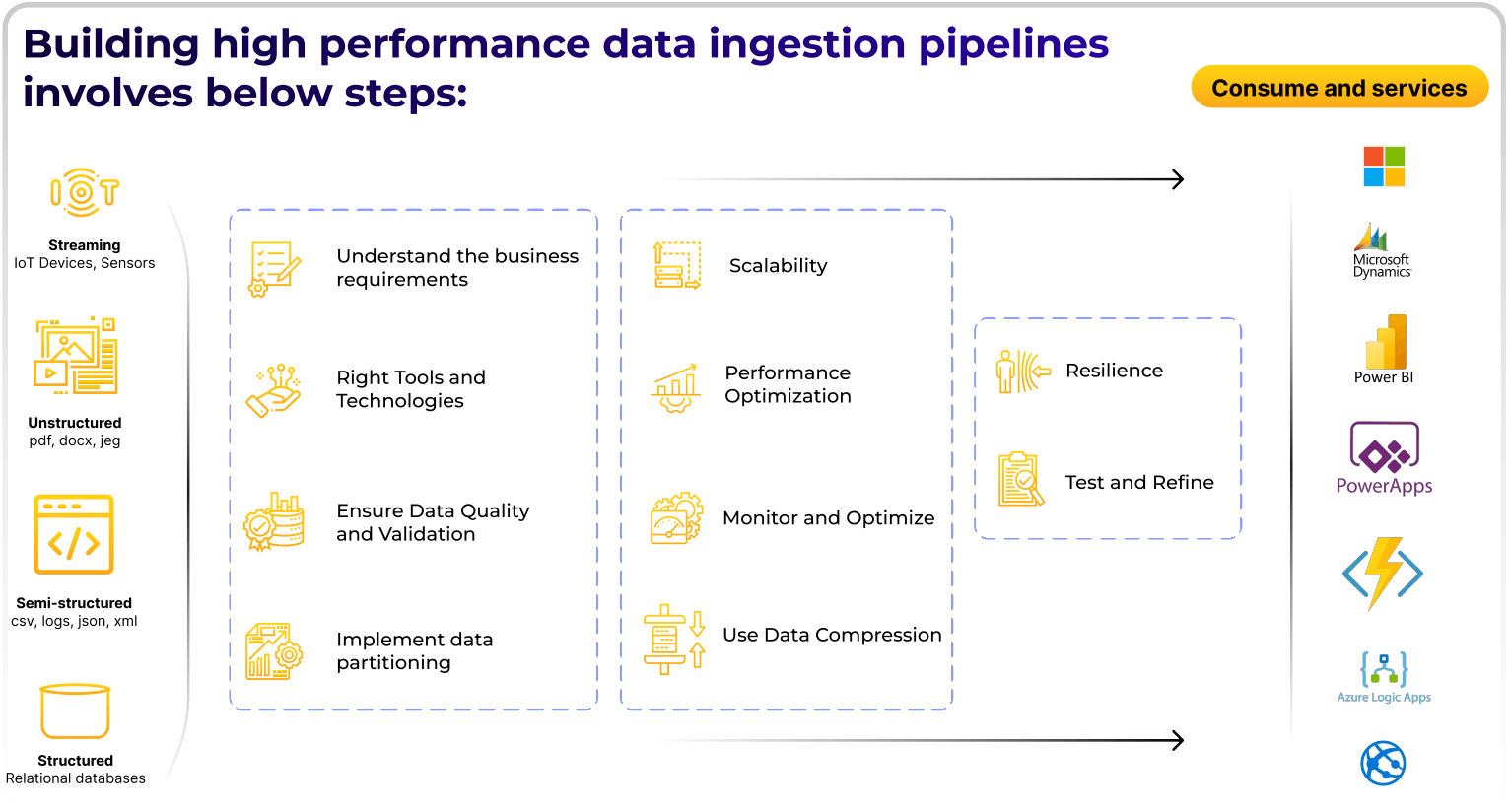How to build high-performance data ingestion pipelines

What is Data Ingestion?
Data ingestion is the method of collecting and importing data from various sources into a database for further processing or analysis. It is an initial step in data integration and data processing pipelines within organizations to build data warehouses for analytic and decision making. Data can originate from distinct sources such as transactional databases, log files, IoT devices, social media platforms, external APIs, spreadsheets, or even cloud services.
What is Data Pipeline?
A data pipeline is a process for transferring data from many sources to any number of destinations, such as data warehouses or business intelligence tools.

Building high performance data ingestion pipelines involves below steps:
- Understand the business requirements
- Scalability
- Resilience
- Right Tools and Technologies
- Performance Optimization
- Ensure Data Quality and Validation
- Monitor and Optimize
- Implement data partitioning
- Use Data Compression
- Test and Refine
Understand the business requirements
Thoroughly Understand the business requirement what data needs to be extracted from where and what is the and destination. When defining performance goals for a data ingestion pipeline, it's important to specify metrics such as throughput, latency, and scalability requirements.
- Identify data sources and Destination: Determine the types of data need to ingest whether its structured, semi structured or streaming and their locations (databases, APIs, files).
- Define data volume and velocity: Determine the amount of data and the frequency which needs to be ingested.
- Specify data quality requirements: Determine the standards for data accuracy, completeness, and consistency.
- Determine latency requirements: Identify the acceptable delays between data generation and availability for analysis.
Scalability and Resilience:
Design the pipeline to scalable horizontally. Implement the mechanism to replicate the data, handling the errors and retries to ensure data reliability.
Choose the Right Tools and Technologies:
Consider using the correct tools and frameworks based on below points. Determine whether the data ingestion is batch processing or stream processing based on real time data needs.
- Data ingestion tools: Select tools like Apache Kafka, Apache Flume, or Amazon Kinesis for data collection and transport.
- Data processing frameworks: Select frameworks like Apache Spark or Apache Flink for data transformation and enrichment.
- Data storage solutions: Select appropriate storage solutions based on your data requirements, such as data warehouses like Snowflake and Redshift, data lakes like Hadoop and S3, or NoSQL databases like MongoDB and Cassandra.
Performance Optimization:
To improve the performance, implement the parallel processing to maximize the throughput, Data compression to reduce the storage and network overhead and implement the caching to optimize the data retrieval timing.
Ensure Data Quality:
Validate and cleanse data in real-time to prevent errors and inconsistencies.
- Validate data: Implement data validation checks to ensure data accuracy and completeness.
- Handle duplicates: Develop mechanisms to identify and handle duplicate data entries.
- Implement data lineage: Track the origin and transformation of data throughout the pipeline.
Monitor and Optimize:
Continuously monitor the pipeline performance and optimize as needed.
- Collect metrics: Monitor key metrics like throughput, latency, error rates, and resource utilization.
- Identify bottlenecks: Determine the metrics to identify performance bottlenecks in the pipeline.
- Optimize data flow: Regulate the pipeline parameters, parallelize tasks, and optimize data transformation logic.
- Scale resources: Increase CPU, memory, network bandwidth resources as needed to handle increased data volumes.
Implement data partitioning
Data partitioning involves dividing data into smaller, manageable parts called partitions. Each partition is processed independently, allowing for parallel execution and improved throughput.
Partitioning Strategy: Choose a partitioning strategy based on ingestion data characteristics and processing needs:
- Key-based Partitioning: Data is partitioned based on a key, ensuring related data is processed by the same consumer or worker.
- Range Partitioning: Data is partitioned based on ranges of values with either data and numerical fields and distributing data evenly across partitions.
- Hash-based Partitioning: Data is partitioned based on a hash function applied to a key, ensuring uniform distribution across partitions.
Partition Size: Keep partitions balanced to ensure no single partition becomes a bottleneck. Uneven partition sizes can lead to skewed workloads and performance issues.
Scalability: Partitioning enables horizontal scalability by allowing additional partitions to be added as data volume grows, without impacting existing partitions.
Fault Tolerance: Ensure data redundancy and replication strategies to handle failures of individual partitions or nodes.
Implement Data Parallelism
Definition: Parallelism involves executing multiple tasks simultaneously, either within a single process or across multiple processes or machines.
Types of Parallelism:
- Task Parallelism: Dividing tasks into smaller subtasks that can be executed concurrently. This is often implemented within a single machine or node.
- Data Parallelism: Distributing data across multiple nodes or processors, where each node processes a subset of the data in parallel. This is common in distributed systems.
Use Data Compression
Data compression is a critical technique in data ingestion pipelines to reduce storage requirements, minimize network bandwidth usage, and improve overall system performance. Here’s how data compression can be effectively utilized in data ingestion:
Common Compression Techniques:
-
Lossless Compression:
- Gzip: A widely used compression algorithm that provides good compression ratios without loss of data. It's efficient for compressing text-based data formats like JSON, CSV, and log files.
- Snappy: Optimized for speed and suitable for compressing data in real-time ingestion scenarios. It's commonly used with Apache Kafka for its low latency. -
Lossy Compression:
- JPEG, MP3, etc.: Used for compressing multimedia data where some loss of quality is acceptable in exchange for significant compression ratios.
Test and Refine
Unit testing must be done in data pipeline which involves validating the correctness of individual components or stages of the pipeline to ensure that they work as expected and handle data accurately. Data pipelines typically involve multiple stages, such as data extraction, transformation, loading, and sometimes complex data processing. Each stage needs to be tested independently to catch errors early and ensure reliability and robustness.
- Unit Testing: Test individual components for functionality.
- Integration Testing: Validate end-to-end data flow and performance under load.

